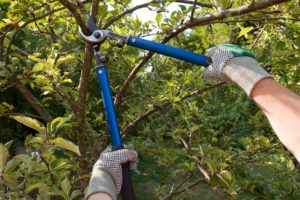
What is pruning? Learn more about what pruning trees and shrubs does to improve their health.
Pruning is the removal of undesirable portions of a plant. Every pruning cut should be well planned because each cut can affect the plant’s growth. After pruning, a plant must seal off every new cut and will do so by compartmentalizing the wound by forming callus or scar tissue. Minor cuts do less damage than major ones. Cuts should leave smooth surfaces without ragged edges or torn bark. You can avoid extra work by carefully pruning and training young plants and by choosing plants with a final size appropriate to their location.
Pruning does not stop plant growth. In fact, pruning stimulates growth. The terminal bud (at the end of a branch) exerts substantial chemical control over the lateral (side) buds lower on the stem. Hormones located in the terminal bud keep lateral buds dormant. Effective pruning manipulates bud growth to the gardener’s advantage. When terminal buds are removed, they release lower buds from growth inhibition and permits them to begin branching. The buds closest below the cut are the ones most likely to grow. Cuts made near the base of a plant can create “bushiness” and regrowth there, but this growth depends upon a plant having viable lower buds.
Regrowth after pruning depends upon the amount of material removed. If a small percentage of a young, vigorously growing branch is pruned, there will be regrowth up and down the remaining branch. When a major portion of that branch is removed, the one or two buds closest to the cut will grow rapidly. Thus, removing just the growing tips generally causes more branching than removing a more significant portion of the branch.
Information sourced from the University of Maryland
Why Should You Prune?
Maintain Plant Health
- Removing all dead, diseased, or damaged branches helps prevent insects and decaying organisms from entering the plant. When removing diseased wood, the cut must be made into the healthy wood below the affected area.
- Branches that cross can injure each other by rubbing and create a wound that requires their removal.
- Pruning can also rejuvenate declining or overgrown shrubs. Pruning will often produce vigorous new growth in many species, and shrubs will fill in over some time.
- Pruning overly dense plants by thinning them out promotes air circulation and reduces the incidence of disease, for example volutella blight of boxwood.
Improve the Quality of Flowers and Fruit
- Flowers and fruits may become smaller in size as their production increases. Pruning woody parts diverts energy to the production of larger, though fewer, flowers and fruit.
- Thinning branches lets light into the canopy’s interior, which is necessary for good fruiting.
- Removing dead flowers and seedpods increases bloom for the following year. On rhododendrons, lilacs, and similar plants, the production of seed pods drains energy from the production of new shoots and flower buds. Therefore, seed pods should be pruned.
Promote the Desired Appearance
- Thinning out trees and shrubs lets light into the interior of plants to reveal interesting patterns of bark, trunk, or branch structure.
- Pruning or shearing can be used to develop a unique form, as in hedges, espaliers, or topiary work. When green shoots grow on a variegated plant, they should be removed to maintain their coloration.
- If a portion of a plant reverts to the wild type, such as strong vertical growth in a weeping tree, those portions should be pruned.
- Small trees often need corrective pruning to establish a solid and attractive shape.
Restrict Growth
- Branches that are hazardous or interfere with power lines should be removed. Homeowners should always use professional pruning services when pruning near power lines.
- Overgrown shrubs should be cut back and restrained.
- Densely branched shade trees can be thinned to reduce the potential for storm damage.
- Multiple shoots growing from a wounded area should be removed.
- Shoots from the rootstock of grafted plants should be pruned.
- Water sprouts, which are soft, rapidly growing vertical growths, should be removed at the trunk or limb from which they grow.
- Suckers, similar to water sprouts but growing from the base of the plant or the roots, should be removed if they are not wanted.
Follow this link from the University of Maryland’s Extension Service to learn how to prune effectively: https://extension.umd.edu/resource/pruning-shrubs-and-hedges-home-garden/
Scientific Plant Service Is Your Go-To Source In Landscape Healthcare
Scientific Plant Service, located in Baltimore, is a privately owned corporation, chartered in Maryland in 1957 by Frank J. Burke. We started as a full-service Arborists specializing in the care of shade trees and ornamental shrubs, but today we are a Lawn Care company that is a huge part of the community. From aquatic environments and snow management to deer and mole control, SPS has services tailored specifically for your lawn and landscape.
We offer services in Maryland, Washington, DC, and Virginia, including: Harford, Baltimore, Carroll, Frederick, Howard, Anne Arundel, Montgomery, Prince Georges, Talbot, Queen Anne’s, Calvert counties in MD, as well as Loudoun County, Fairfax County, Arlington, Alexandria, and Falls Church in VA. For more information, contact us online, or call us at 410-321-0970. Be sure to follow us on Facebook, Twitter, LinkedIn, Instagram, and Pinterest.

